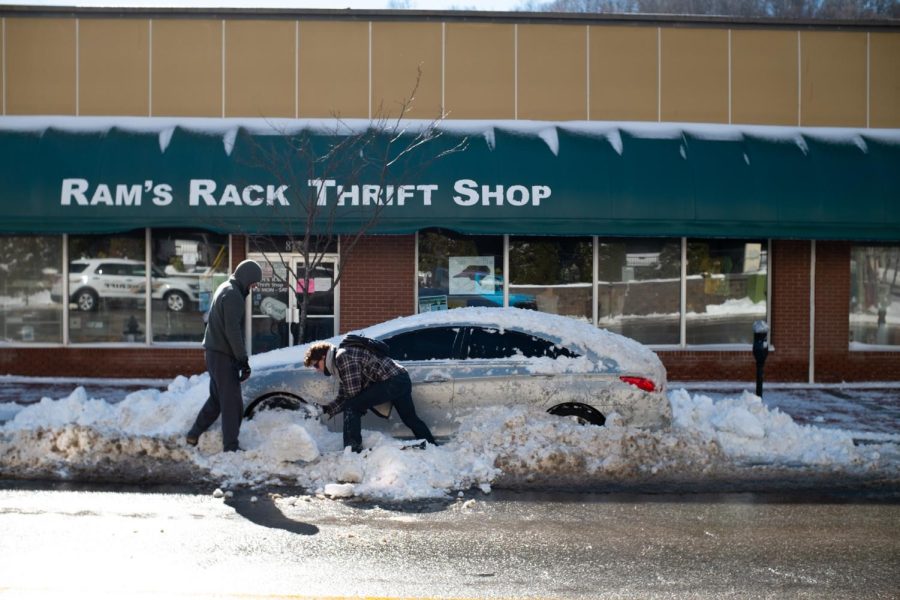From Jan. 15-20, Boone experienced the heaviest snowfall of the season so far, accumulating up to five inches by Jan. 21. With the winter weather brought concerns about roads, work and class cancellations and salt, notably the contamination and corrosion that comes with it.
Shea Tuberty is an App State biology professor and teaches classes like Invertebrate Zoology, Ecotoxicology and Belize Reef and Rainforest Ecology. He is a part of AppAqua, a research team at App State focused on understanding how humans and the environment interact, and the impact that has on water resources.
Tuberty said the amount of concern he received about salinization, or saltiness, of streams from road salt caused him to make it something he wanted to focus on.
“I’ve been at App State 21 years,” Tuberty said. “It was pretty clear to me after getting here, that was one of the major concerns of all students, every winter. It came up in conversation all the time. People would contact me and ask me how toxic it was.”
He said Boone Creek is one of the worst that he has monitored since his time at App State. The creek runs through App State’s campus and Durham Park and joins with Hodges Creek behind Appalachian Mountain Brewery. The two then meet with Winkler’s Creek, which eventually turns into East Fork and Middle Fork Rivers, which both feed into South Fork River, a tributary of the New River.
“There’s just so many cars parking and dripping fluids on the ground,” Tuberty said. “You don’t see it, but the car exhaust actually contributes to all kinds of nitrates, sulfates and chlorides that end up as dust on the surface of the roads. That gets washed off in rain storms, and after snow storms melt.”
William Anderson, a hydrogeology professor at App State, studies how contaminants move through the ground. He said when he was in graduate school he did a considerable amount of work with salt contamination. Anderson said he started measuring salinity levels in water in 2006 when he saw how much was being used in Boone.
“Our streams should be somewhere around zero milligrams of salt per liter of water, but if we go out to Boone Creek and measure the salinity in the summer, it’s going to be anywhere from 100 to 200 milligrams per liter. The drinking water standard is 250 milligrams per liter,” Anderson said.
Anderson clarified that while the drinking water standard is 250 milligrams per liter, Boone Creek’s salinity starts to go down as it feeds into other creeks and rivers.
According to the Town of Boone website, Boone gets its drinking water from the Greg Young New River Intake, the Southfork Intake and the intake on Winkler Creek.
Tuberty explained that climate change is increasing the number and intensity of precipitation events. These events in Boone and surrounding areas are dependent on if there is an El Niño event in the southeastern Pacific Ocean.
“El Niño is a natural event that is being impacted by climate change and will get more intense,” Tuberty said.
Tuberty said in 2018, Boone had seven nuisance flooding events.
“By nuisance I mean, a few of the major roads and arteries in Boone get covered and they’re impassable, or the Boone Mall parking lot gets full of water,” Tuberty said.
In 2019, he said Boone had five more floods. He said in a typical year, for 85 years, Boone has gotten about 1.8 floods annually.
“But since 2019, we are no longer in an El Niño, we went to La Niña, which is a lot more docile for the southeastern United States – we’ve had almost zero flooding events,” Tuberty said.
Tuberty predicts that with the return of El Niño this year, there will be a return of precipitation events as well. He connects this increase in precipitation and flooding from climate change to the salt.
Tuberty and Anderson both explained what the hyporheic zone is. Tuberty said when there is a lot of salt in the creeks, the flooding pushes the salt into the hyporheic zone, which is an underground water supply to creeks. This zone is what keeps creeks flowing, even in droughts. When the salt gets into this zone, it takes longer for it to get to the creek and leave the watershed.
Tuberty said that he has seen the baseline salinity at Boone Creek go up year after year, even without snow and in the late summer. “Summer to summer to summer, that level was going up too. Because we’ve had a couple of years without intense rainfalls or a lot of flooding, that number has come back down to some extent.”
When it comes to alternatives and solutions, Tuberty brings up a brine that’s in use by the Town of Boone.
“It seems like we’ve moved most of our road salt application to a brine, which uses less salt, but is more effective at controlling ice,” he said.
Anderson, who lived in Maine for part of his life, saw another alternative with sand.
“They didn’t just apply straight salt, they did a mixture and of course, the salt would dissolve,” Anderson said. “But at the end of the winter they would go around and clean all of the sand back up.”
Some of the sand was able to be reused.
Another issue both Anderson and Tuberty brought up was the corrosive properties of salt. At a seminar given at Clemson University in 2015, Tuberty presented that the U.S. loses $50 billion a year from corrosion caused by road salt.
George Santucci, the Sustainability and Special Projects Manager for the Town of Boone, was the Executive Director for the New River Conservancy for 15 years.
Santucci said concrete is impacted by salt more than asphalt, so sidewalks tend to be affected more than the roads.
“But it certainly does affect asphalt as well. If it starts to crumble and then water pulls there, then freezes, that really is what exacerbates the breakdown of those materials,” Santucci said.
Despite the concern for salt use, a study from 2009 by the American Highway Users Alliance notes that states have seen a loss of $300-$700 million in just a one-day shutdown.
Tuberty said that the use of salt comes down to safety. He said that sometimes it is necessary for long-term winter weather or especially thick ice.
“The challenge is in the United States of America. If a water quality violation doesn’t fit the Clean Water Act, then there are no mechanisms for action or for any government entity to do anything about it. That’s the law that we have to follow to enforce water quality,” Santucci said. “Even though people may be right about something, if it’s not violating a statute or a law then there’s no regulatory authority to do anything about it.”
Shallow creeks like Boone Creek and Winkler’s Creek run through App State’s campus and the Town of Boone. The salinity of these creeks increases with the salting of local roads during the winter months.




James Sharp • Feb 22, 2024 at 9:19 am
Great article! Thank you for bringing attention to this issue!